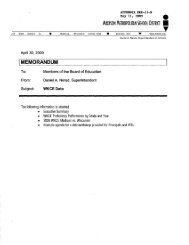interpretations of standards-based grading and reporting - School ...
interpretations of standards-based grading and reporting - School ...
interpretations of standards-based grading and reporting - School ...
You also want an ePaper? Increase the reach of your titles
YUMPU automatically turns print PDFs into web optimized ePapers that Google loves.
Appendix LLL - 2 - 8<br />
August 17, 2009<br />
Executive Summary<br />
Teachers' <strong>interpretations</strong> <strong>of</strong> <strong>st<strong>and</strong>ards</strong>-<strong>based</strong> <strong>grading</strong> <strong>and</strong> <strong>reporting</strong>:<br />
Learning a new language <strong>and</strong> culture<br />
Introduction<br />
Sara Hagen<br />
University <strong>of</strong> Wisconsin-Madison<br />
April 21, 2009<br />
In September 2008, the Madison Metropolitan <strong>School</strong> District (MMSD) began<br />
implementation <strong>of</strong> <strong>st<strong>and</strong>ards</strong>-<strong>based</strong> <strong>grading</strong> <strong>and</strong> <strong>reporting</strong> in all district middle schools.<br />
This paper is a study <strong>of</strong> teachers' responses to the new system <strong>of</strong> <strong>grading</strong>, <strong>based</strong> on<br />
interviews <strong>and</strong> surveys conducted during <strong>and</strong> after the first quarter <strong>of</strong> the 2008-09 school<br />
year. I seek to provide a clear underst<strong>and</strong>ing <strong>of</strong> both the intentions behind the<br />
implementation <strong>and</strong> its early effects on teachers' beliefs <strong>and</strong> actions, an underst<strong>and</strong>ing<br />
which may facilitate further implementation within the district <strong>and</strong> have possible<br />
implications for other districts considering a transition to <strong>st<strong>and</strong>ards</strong>-<strong>based</strong> <strong>grading</strong>. This<br />
document is a summary <strong>of</strong> the much longer report. For elaboration, please refer to the<br />
indicated sections <strong>of</strong> the main document.<br />
Two main purposes <strong>of</strong> <strong>st<strong>and</strong>ards</strong>-<strong>based</strong> <strong>grading</strong> [page 2]<br />
In <strong>st<strong>and</strong>ards</strong>-<strong>based</strong> <strong>grading</strong>, academic achievement is separated from behavior,<br />
effort, <strong>and</strong> progress. Students' achievement is evaluated with respect to a grade-level<br />
st<strong>and</strong>ard. Instead <strong>of</strong> a single grade for a course, teachers report on multiple <strong>st<strong>and</strong>ards</strong> to<br />
give a more accurate picture <strong>of</strong> what students know <strong>and</strong> are able to do. Teachers <strong>and</strong><br />
students focus on meeting those <strong>st<strong>and</strong>ards</strong>. The two main purposes <strong>of</strong> <strong>st<strong>and</strong>ards</strong>-<strong>based</strong><br />
<strong>grading</strong> are improved accountability for student achievement <strong>and</strong> improved learning.<br />
1) Improved accountability: As teachers <strong>and</strong> students develop a shared<br />
underst<strong>and</strong>ing <strong>of</strong> <strong>st<strong>and</strong>ards</strong> <strong>and</strong> criteria, <strong>grading</strong> loses its mystery <strong>and</strong> gains a<br />
direct relationship to learning. By exp<strong>and</strong>ing that shared underst<strong>and</strong>ing<br />
throughout the school <strong>and</strong> community, the system <strong>of</strong> <strong>st<strong>and</strong>ards</strong>-<strong>based</strong> <strong>grading</strong><br />
becomes transparent <strong>and</strong> fair, a force for accountability.<br />
2) Improved learning: St<strong>and</strong>ards-<strong>based</strong> <strong>grading</strong> improves teaching <strong>and</strong> learning<br />
through improved feedback to teachers <strong>and</strong> students <strong>and</strong> a new approach to<br />
student motivation. Teachers use knowledge <strong>of</strong> how students are doing with<br />
respect to the <strong>st<strong>and</strong>ards</strong> to plan further instruction. Students likewise use<br />
feedback to adjust their strategies <strong>and</strong> improve their work.<br />
Conceptualizing the transition as a process <strong>of</strong> language learning [page 5]<br />
During the implementation <strong>of</strong> <strong>st<strong>and</strong>ards</strong>-<strong>based</strong> <strong>grading</strong>, teachers explained that the<br />
new grades don't feel right-something is being lost in translation from the traditional<br />
system to the <strong>st<strong>and</strong>ards</strong>-<strong>based</strong> system. In this paper, I examine the ways in which<br />
learning <strong>st<strong>and</strong>ards</strong>-<strong>based</strong> <strong>grading</strong> is like learning a new language <strong>and</strong> culture.
Sara Hagen<br />
Methods <strong>and</strong> organization [page 6]<br />
The following analysis is <strong>based</strong> on observations <strong>of</strong> the district's Summer Institute<br />
on Underst<strong>and</strong>ing by Design, two interviews each with nine teachers in two different<br />
middle schools, <strong>and</strong> responses to a self-administered questionnaire sent to a<br />
representative sample <strong>of</strong> all district middle school teachers <strong>of</strong> Language Arts, Math,<br />
Science, Social Studies, <strong>and</strong> World Languages. [See page 127 for a thorough explanation<br />
<strong>of</strong> research procedures <strong>and</strong> statistical techniques.]<br />
(<br />
(<br />
\<br />
(<br />
Page 2
Sara Hagen<br />
Chapter 1: A New Culture <strong>of</strong> St<strong>and</strong>ards-Based Grading<br />
Grading <strong>and</strong> assessment practices are cultural practices. These practices feel right<br />
<strong>and</strong> make sense to teachers, students, <strong>and</strong> parents; yet, these practices are <strong>of</strong>ten<br />
unexamined, as are the beliefs that underlie those practices. In this section I examine the<br />
relationship between <strong>st<strong>and</strong>ards</strong>-<strong>based</strong> perspectives on <strong>grading</strong> <strong>and</strong> <strong>st<strong>and</strong>ards</strong>-<strong>based</strong><br />
practices <strong>of</strong> <strong>grading</strong> in four areas: I) beliefs about learning, 2) beliefs about students, 3)<br />
beliefs about the role <strong>of</strong> teachers, <strong>and</strong> 4) beliefs about accountability. Increased teacher<br />
consensus around these four areas should lead to new practices <strong>of</strong> planning, instruction,<br />
assessment, <strong>and</strong> <strong>grading</strong>. It is therefore important that teachers have time not just to<br />
implement new <strong>grading</strong> practices, but to reflect on the beliefs that support a system <strong>of</strong><br />
<strong>st<strong>and</strong>ards</strong>-<strong>based</strong> <strong>grading</strong>.<br />
St<strong>and</strong>ards-Based St<strong>and</strong>ards-Based Considerations <strong>and</strong> Findings<br />
Perspectives Practices <strong>of</strong> Interest<br />
MMSD teachers described<br />
Learning: • Lesson plans are •<br />
• Students do not receive <strong>based</strong> on <strong>st<strong>and</strong>ards</strong> a focus on <strong>st<strong>and</strong>ards</strong> as the<br />
knowledge (key concepts). largest benefit <strong>of</strong><br />
(transmission model). • Grade books are <strong>st<strong>and</strong>ards</strong>-<strong>based</strong> <strong>grading</strong>.<br />
• Students construct arranged by st<strong>and</strong>ard • Some <strong>st<strong>and</strong>ards</strong> have been<br />
knowledge instead <strong>of</strong> revised recently.<br />
(constructivism). assignment type • Teachers found more<br />
[page 9] (homework, quizzes, specific math power<br />
etc.)<br />
<strong>st<strong>and</strong>ards</strong> easier to<br />
underst<strong>and</strong> than general<br />
<strong>st<strong>and</strong>ards</strong> in other areas.<br />
• 89% <strong>of</strong> teachers have<br />
changed their grade book<br />
setup as <strong>of</strong> December<br />
2008.<br />
Students: • Provide multiple • Consider clarifying retake<br />
• All students can learn. opportunities for policies.<br />
Bell curves do not success. • May require reallocation<br />
apply. Intelligence is • Use formative <strong>of</strong> resources to students<br />
not a fixed construct. assessment results to who need more time to<br />
• Students learn in adjust instruction. learn.<br />
different ways. • Value mistakes as • Scores <strong>of</strong> 1, 2, 3, 4 alone<br />
[page 13] natural <strong>and</strong> helpful; provide insufficient<br />
encourage student feedback to studentsrisk-taking<br />
on<br />
must be combined with<br />
challenging tasks. additional information.<br />
Page 3
Sara Hagen<br />
St<strong>and</strong>ards-Based St<strong>and</strong>ards-Based Considerations <strong>and</strong> Findings <strong>of</strong><br />
Persnectives Practices Interest<br />
Teachers: • Learning skills • Teachers <strong>and</strong> parents have similar<br />
• Homework is (including beliefs about homework,<br />
part <strong>of</strong>a homework commonly viewing it as<br />
formative completion) are currency-payment for effort<br />
assessment reported separately expended. 66% <strong>of</strong> parents<br />
system. from achievement. surveyed by the MMSD in Spring<br />
• Homework • Consistently help 2008 did not support separation <strong>of</strong><br />
grades cannot be students to make homework from the grade.<br />
used as rewards the connection • Students at this age may not have<br />
or punishments. between made the connection between<br />
• Teachers have a homework <strong>and</strong> homework <strong>and</strong> achievement.<br />
responsibility to achievement. • Although group grades are<br />
help students • Do not use zeroes discouraged, group work is still<br />
develop agency, or group grades. beneficial for students.<br />
a sense <strong>of</strong> • Use student- • Student-centered assessment<br />
control over centered includes creating criteria with<br />
their learning. assessment students, involving students in<br />
[page 20] practices. record-keeping <strong>and</strong><br />
• Provide all<br />
parent/community communication.<br />
students with the • Many assignments must be revised<br />
opportunity for a 4 or rethought. Not all assignments<br />
(<br />
through<br />
have a "4" level as currently<br />
differentiated<br />
written.<br />
assignments.<br />
(<br />
Accountability: • Communicate • Teachers' pr<strong>of</strong>essional judgment is<br />
• Being clearly with more reliable <strong>and</strong> valid than<br />
accountable parents <strong>and</strong> external test results. Classroom<br />
means providing community. assessment should be part <strong>of</strong> the<br />
accurate grades, • Develop school <strong>of</strong>ficial accountability system.<br />
opportunities, cultures that • Modeling from colleagues is<br />
fair treatment, promote highly influential.<br />
<strong>and</strong> high collaboration • Teachers need time for both<br />
expectations for within a systematic individual reflection <strong>and</strong> extensive<br />
all students. framework <strong>of</strong> collaboration.<br />
[page 37]<br />
integrated<br />
pr<strong>of</strong>essional<br />
development.<br />
Page 4<br />
(
Sara Hagen<br />
I asked teachers how much they have changed their instructional activities, the<br />
amount or type <strong>of</strong> homework assigned, <strong>and</strong> the ways they collect information about<br />
students' progress since the implementation <strong>of</strong> <strong>st<strong>and</strong>ards</strong>-<strong>based</strong> <strong>grading</strong> [page 41].<br />
Changes in one area were usually significantly correlated with changes in other areas,<br />
with the largest amount <strong>of</strong> change in the area <strong>of</strong> collecting information about students'<br />
progress.<br />
About half <strong>of</strong> teachers are changing their instructional practices, while about half<br />
or not. When asked, "Do other colleagnes in your content area(s) assign a score <strong>of</strong> 1,2,<br />
3, <strong>and</strong> 4 on the power <strong>st<strong>and</strong>ards</strong> the same way you do?" [page 42], two significantly<br />
different groups emerged. Those who answered "yes" to this question were much clearer<br />
on the difference between a 1 <strong>and</strong> a 2, a 2 <strong>and</strong> a 3, <strong>and</strong> a 3 <strong>and</strong> a 4 than teachers who<br />
answered "no." They reported that their students <strong>and</strong> students' parents have a clearer<br />
underst<strong>and</strong>ing <strong>of</strong> the report cards. They were more likely to have made changes to data<br />
collection methods, <strong>and</strong> overall they were much more familiar with <strong>st<strong>and</strong>ards</strong>-<strong>based</strong><br />
<strong>grading</strong>. I believe there is a connection between the amount <strong>of</strong> time these teachers spend<br />
collaborating with their colleagues <strong>and</strong> the changes they have made. Follow-up is needed<br />
to better underst<strong>and</strong> these interactions <strong>and</strong> the likely benefits <strong>of</strong> collaboration on<br />
consistent implementation <strong>of</strong> <strong>st<strong>and</strong>ards</strong>-<strong>based</strong> <strong>grading</strong>.<br />
On questions about priorities for pr<strong>of</strong>essional development, several items showed<br />
significant correlations. It may be advisable to identify teachers with an interest in<br />
specific rubrics, differentiation, <strong>and</strong> examining student work--core practices <strong>of</strong><br />
<strong>st<strong>and</strong>ards</strong>-<strong>based</strong> <strong>grading</strong>. Teachers who showed the most interest in these activities were<br />
most interested in all other pr<strong>of</strong>essional development options.<br />
Page 5
Sara Hagen<br />
Chapter 2: A New Vocabulary <strong>of</strong> St<strong>and</strong>ards-Based<br />
Grading<br />
Implementing <strong>st<strong>and</strong>ards</strong>-<strong>based</strong> <strong>grading</strong> requires developing <strong>and</strong> sharing a<br />
language <strong>of</strong> <strong>st<strong>and</strong>ards</strong> <strong>and</strong> criteria. Language specific to the MMSD implementation <strong>of</strong><br />
<strong>st<strong>and</strong>ards</strong>-<strong>based</strong> <strong>grading</strong> includes "underst<strong>and</strong>ing," "power <strong>st<strong>and</strong>ards</strong>," the labels "I,"<br />
"2," "3," <strong>and</strong> "4," <strong>and</strong> "trend scores." Knowing how teachers are defining <strong>and</strong> using<br />
these terms is a key step in facilitating or redirecting conversations about them. Teachers<br />
very much want to have a shared underst<strong>and</strong>ing <strong>of</strong> these terms.<br />
(<br />
Underst<strong>and</strong>ing [page 47]<br />
The MMSD has chosen to use "underst<strong>and</strong>ing" as the key descriptor for the labels<br />
I, 2, 3, <strong>and</strong> 4 in their <strong>st<strong>and</strong>ards</strong>-<strong>based</strong> <strong>grading</strong>. Teachers described underst<strong>and</strong>ing in ways<br />
that fell into three categories: statements about the basic nature <strong>of</strong> underst<strong>and</strong>ing,<br />
statements describing the process <strong>of</strong> underst<strong>and</strong>ing, <strong>and</strong> statements about how<br />
underst<strong>and</strong>ing is visible in students' work. Of these, the third category has the most<br />
potential for developing a shared, practical underst<strong>and</strong>ing <strong>of</strong> underst<strong>and</strong>ing.<br />
Embodied metaphors [page 48]<br />
In this section I use cognitive scientists Lak<strong>of</strong>f <strong>and</strong> Johnson's (1999) work to<br />
identify teachers' metaphors for underst<strong>and</strong>ing that are <strong>based</strong> on human beings'<br />
experience as embodied persons. These include underst<strong>and</strong>ing as ...<br />
• Getting <strong>and</strong> processing information<br />
• Seeing<br />
• Movement through physical space<br />
• Hitting a target or reaching a goal<br />
• Mastery or being in control<br />
• The result <strong>of</strong> strength<br />
These metaphors provide very general, summative statements about a student's<br />
underst<strong>and</strong>ing that cannot be used reliably <strong>and</strong> consistently to inform a conversation on<br />
learning or to provide a basis for formative feedback.<br />
(<br />
Process metaphors [page 50]<br />
Teachers' metaphors about the process <strong>of</strong> underst<strong>and</strong>ing may provide the basis for<br />
useful conversations about teaching <strong>and</strong> learning. These include underst<strong>and</strong>ing as ...<br />
• Sudden - a "Eureka" moment<br />
• A slow process<br />
• Cumulative<br />
• Something forced upon the learner<br />
• Completeness<br />
• Having different levels<br />
These metaphors provoke questions about how learning occurs <strong>and</strong> what teachers can do<br />
to best facilitate learning.<br />
(<br />
Page 6
Sara Hagen<br />
Underst<strong>and</strong>ing as visible in students' work [page 53]<br />
Teachers also described underst<strong>and</strong>ing using parts <strong>of</strong> the framework presented in<br />
Underst<strong>and</strong>ing By Design (Wiggins & McTighe, 2005). This framework includes the<br />
following "Six facets <strong>of</strong> underst<strong>and</strong>ing";<br />
• Explaining<br />
• Interpreting<br />
• Applying<br />
• Having Perspective<br />
• Empathizing<br />
• Self-Knowledge<br />
Teachers described assignments that target one or more <strong>of</strong> these six facets. Overall, use<br />
<strong>of</strong> the six facets was much less than the use <strong>of</strong> embodied or process metaphors for<br />
underst<strong>and</strong>ing. If teachers are to develop a shared language <strong>of</strong> criteria <strong>based</strong> on student<br />
underst<strong>and</strong>ing, more extensive conversations on this topic are needed.<br />
"Full" underst<strong>and</strong>ing: A problematic metaphor? [page 57]<br />
Because the term "full" underst<strong>and</strong>ing makes use <strong>of</strong> an embodied metaphor <strong>and</strong><br />
does not focus on an aspect <strong>of</strong> underst<strong>and</strong>ing that is visible in students' work, the district<br />
may wish to reconsider use <strong>of</strong> this term for the level 3 score.<br />
Power <strong>st<strong>and</strong>ards</strong> [page 58]<br />
Douglas Reeves (1998; 2000) coined the term "power <strong>st<strong>and</strong>ards</strong>" as the most<br />
important <strong>st<strong>and</strong>ards</strong> in a given subject or grade level. The MMSD has adopted this term<br />
for a similar concept. Teachers report a grade for each student on two, three, or four<br />
power <strong>st<strong>and</strong>ards</strong> in each subject area. In math, these are content-specific <strong>st<strong>and</strong>ards</strong> such<br />
as the ability to solve problems with factors <strong>and</strong> mUltiples, or the ability to read <strong>and</strong><br />
interpret graphs. In other subjects, the power <strong>st<strong>and</strong>ards</strong> are more general areas <strong>of</strong><br />
thinking skill such as Content Knowledge, Analysis <strong>and</strong> Application, Conducting<br />
Investigations, or Writing. The general power <strong>st<strong>and</strong>ards</strong> are used with all topics in a<br />
course, while the specific math power <strong>st<strong>and</strong>ards</strong> correspond to units <strong>of</strong> instruction. These<br />
different systems have various pros <strong>and</strong> cons.<br />
The more specific power <strong>st<strong>and</strong>ards</strong> provide more specific feedback to parents <strong>and</strong><br />
students. Parents then know for which content areas their children are most successful or<br />
need the most remediation. The broader power <strong>st<strong>and</strong>ards</strong> help teachers to focus on the<br />
balance <strong>of</strong> skills in each class. For example, the Analysis <strong>and</strong> Application power<br />
st<strong>and</strong>ard encourages Social Studies teachers to think about how their assigrunents include<br />
higher level thinking skills; in World Languages, teachers must balance oral <strong>and</strong> written<br />
communication.<br />
Power <strong>st<strong>and</strong>ards</strong> quickly become the <strong>st<strong>and</strong>ards</strong> that matter most <strong>and</strong> the categories<br />
that teachers use to think about teaching. It is therefore important to consider carefully<br />
the power <strong>st<strong>and</strong>ards</strong> that are chosen for the report card. Just as it took several years for<br />
teachers to underst<strong>and</strong> <strong>and</strong> use the <strong>st<strong>and</strong>ards</strong> documents for their areas, it will take time<br />
for teachers to underst<strong>and</strong> the power <strong>st<strong>and</strong>ards</strong>, use them in planning <strong>and</strong> assessment, <strong>and</strong><br />
explain them to parents. Teachers who helped develop the power <strong>st<strong>and</strong>ards</strong> for their<br />
Page 7
Sara Hagen<br />
subject area had a much clearer underst<strong>and</strong>ing <strong>of</strong> those power <strong>st<strong>and</strong>ards</strong>. Several teachers<br />
requested clearer definitions <strong>of</strong> the Reading power <strong>st<strong>and</strong>ards</strong>.<br />
Criteria [page 64]<br />
No system <strong>of</strong> <strong>st<strong>and</strong>ards</strong>-<strong>based</strong> <strong>grading</strong> can exist without fully developed criteria<br />
for student work. I asked teachers to explain the difference between scores (I, 2, 3, <strong>and</strong><br />
4), focusing especially on the difference between a 3 <strong>and</strong> a 4. The district is developing<br />
<strong>grading</strong> guides that are intended to help teachers distinguish among levels <strong>of</strong><br />
performance. However, these <strong>grading</strong> guides are not intended as rubrics for everyday<br />
classroom use. Sample rubrics for each subject (<strong>and</strong> accompanying examples <strong>of</strong> student<br />
work) will need to be developed in addition to the <strong>grading</strong> guides.<br />
Teachers' descriptions <strong>of</strong> criteria for a 3 or 4 fell into three basic categories:<br />
vague, evaluative, <strong>and</strong> feedback-oriented.<br />
• Vague criteria [page 66] do not help to clarify specific differences.<br />
• Evaluative criteria [page 67] are judgments about the student's work in relation to<br />
objectives <strong>of</strong> the course <strong>and</strong> about the student's likelihood <strong>of</strong>future success. As<br />
far as I know, there is no district document that specifies what a I, 2, 3, or 4<br />
should represent in making decisions about course selection, remediation,<br />
tutoring, or retention. Consensus on <strong>and</strong> consistent application <strong>of</strong> these meanings<br />
would enhance the overall integrity <strong>of</strong> the <strong>st<strong>and</strong>ards</strong>-<strong>based</strong> system.<br />
• Feedback-oriented criteria [page 68] include enough information about the<br />
desired performance to help teachers apply them consistently <strong>and</strong> for students to<br />
underst<strong>and</strong> how to improve their work from one level to the next. These include<br />
use <strong>of</strong> evidence <strong>and</strong> sources, perspective-taking, underst<strong>and</strong>ing significance,<br />
quality (including detail <strong>and</strong> accuracy), quantity, <strong>and</strong> student independence.<br />
These specific criteria map well onto the six facets <strong>of</strong> underst<strong>and</strong>ing described<br />
above.<br />
Criteria may be general or subject-specific. Use <strong>of</strong> general criteria across subject areas<br />
can facilitate student underst<strong>and</strong>ing if teachers use the criteria the same way. Subjectspecific<br />
criteria are <strong>of</strong>ten needed to provide more detailed feedback to students.<br />
Development <strong>of</strong> criteria <strong>and</strong> technically sound rubrics is a collaborative process that<br />
begins with examples <strong>of</strong> student work.<br />
(<br />
(<br />
Trend scores [page 73]<br />
Instead <strong>of</strong> an average grade for the quarter, teachers now calculate a trend score<br />
for each student for each power st<strong>and</strong>ard. As a summative grade for the quarter, the trend<br />
score represents that student's level <strong>of</strong> achievement. This means taking into account the<br />
most recent <strong>and</strong> most consistent information about a student. The teachers I interviewed<br />
were very clear about the method <strong>and</strong> purpose <strong>of</strong> creating trend scores. Some teachers<br />
surveyed were less clear about their purpose. In future in-services about trend scores,<br />
district administrators may wish to repeat the rationale for their use <strong>and</strong> their relationship<br />
to formative assessment. Teachers have several practical questions about the use <strong>of</strong> trend<br />
scores, including whether or how to weight different types <strong>of</strong> assignments when<br />
calculating a trend score [page 74].<br />
(<br />
Page 8
Sara Hagen<br />
Chapter 3: L 1 Interference <strong>and</strong> Interlanguage<br />
While learning the language <strong>of</strong> <strong>st<strong>and</strong>ards</strong>-<strong>based</strong> <strong>grading</strong>, teachers are combining<br />
first language (traditional <strong>grading</strong> practices) with new language to create an<br />
interlanguage. This "interlanguage" is a logical transitional step. The two main<br />
interfering practices from traditional <strong>grading</strong> are use <strong>of</strong> percentages <strong>and</strong> use <strong>of</strong> letter<br />
grades. In trying to create a "direct translation" or one-to-one correspondence between<br />
percentages, letter grades, <strong>and</strong> <strong>st<strong>and</strong>ards</strong>-<strong>based</strong> grades, teachers face added frustration.<br />
Awareness <strong>of</strong> <strong>grading</strong> practices that are still influenced by traditional <strong>grading</strong> is the first<br />
step in addressing them, so teachers can move toward a more complete adoption <strong>of</strong><br />
<strong>st<strong>and</strong>ards</strong>-<strong>based</strong> <strong>grading</strong>.<br />
Percentages [page 77]<br />
Teachers are accustomed to assigning grades as percentages. Many teachers have<br />
created systems to convert these percentages to a 1,2,3, or 4. The range <strong>of</strong> 100 possible<br />
scores <strong>of</strong>fers more flexibility to teachers than the four <strong>st<strong>and</strong>ards</strong>-<strong>based</strong> scores or the<br />
traditional five letter grades. Because teachers' <strong>interpretations</strong> <strong>of</strong> the 1, 2, 3, <strong>and</strong> 4 vary,<br />
their systems for converting from percentages also vary. I include four sample <strong>grading</strong><br />
scales [page 79]. A score <strong>of</strong>2 ranges from 60 to 89 percent, grades which previously<br />
corresponded to aD, C, or B. Scores including half-point intervals [see pages 81 <strong>and</strong> 82<br />
for a sample] could increase the accuracy <strong>of</strong> grades <strong>and</strong> decrease teachers' frustration<br />
with the 4-point system.<br />
Letter grades [page 83]<br />
Currently, teachers assign ai, 2, 3, or 4 for each power st<strong>and</strong>ard. If desired,<br />
teachers also assign weights to each power st<strong>and</strong>ard. The grade book s<strong>of</strong>tware then<br />
calculates a weighted average <strong>of</strong> each student's grades to determine a letter grade for<br />
each subject. Letter grades were retained by the district in order to provide continuity for<br />
parents during the transition. Based on teachers' comments, I recommend phasing out<br />
letter grades for the following reasons;<br />
• The purpose <strong>of</strong> <strong>st<strong>and</strong>ards</strong>-<strong>based</strong> <strong>grading</strong> is to provide clear information about<br />
students' progress on individual <strong>st<strong>and</strong>ards</strong>. Amalgamating this information into a<br />
single score seems to defeat this purpose.<br />
• There is no shared meaning <strong>of</strong> the letter grades.<br />
• Some teachers wonder whether a 3, which represents mastery, should be an A.<br />
Dividing lines will always be arbitrary.<br />
• The grades produced by the new system are sometimes very different from those<br />
produced by the traditional <strong>grading</strong> system, which makes the grades seem<br />
incorrect or confusing to teachers <strong>and</strong> parents <strong>and</strong> makes it more difficult to focus<br />
on measuring student underst<strong>and</strong>ing.<br />
• Learning skills do not affect the letter grade, which suggests that they are less<br />
important or unimportant.<br />
• Teachers sometimes adjust the letter grades or <strong>st<strong>and</strong>ards</strong>-<strong>based</strong> scores, resulting in<br />
inconsistencies.<br />
• Letter grades continue to be associated with a norm-referenced system <strong>of</strong> <strong>grading</strong>,<br />
<strong>and</strong> subtly reinforce teachers' expectation <strong>of</strong> a bell-shaped distribution <strong>of</strong> grades.<br />
Page 9
Sara Hagen<br />
Letter grades <strong>and</strong> weighting <strong>of</strong> power <strong>st<strong>and</strong>ards</strong> [page 8S]<br />
If letter grades are eventually phased out, it would be unnecessary to have a<br />
district consensus on weighting <strong>of</strong> power <strong>st<strong>and</strong>ards</strong>. Nonetheless, discussions <strong>of</strong> issues<br />
raised by the question <strong>of</strong> weighting could help to increase consistency <strong>and</strong>lor clarify<br />
curricular approaches. Weighting <strong>of</strong> power <strong>st<strong>and</strong>ards</strong> raises the following questions:<br />
• Are power <strong>st<strong>and</strong>ards</strong> in a given subject equally important?<br />
• Should power <strong>st<strong>and</strong>ards</strong> be weighted <strong>based</strong> on their importance <strong>and</strong>lor <strong>based</strong> on<br />
the emphasis given to each one in class?<br />
• Should more important power <strong>st<strong>and</strong>ards</strong> have more assessments?<br />
• If a st<strong>and</strong>ard has not been addressed yet or a summative assessment has not been<br />
given, how should that be reported on the report card?<br />
• Should the same grade for Reading Comprehension count in both 6 th grade<br />
Reading <strong>and</strong> Language Arts?<br />
• Should weights remain consistent from quarter to quarter, or can the weights<br />
change during the year?<br />
• Should higher-level thinking power <strong>st<strong>and</strong>ards</strong> like Analysis <strong>and</strong> Application<br />
receive more weight than Content Knowledge power <strong>st<strong>and</strong>ards</strong>?<br />
• Should weighting be determined at the beginning or end <strong>of</strong> the quarter?<br />
• What is the most important goal or power st<strong>and</strong>ard in each course?<br />
If priorities in any course are redefmed, teachers may require additional time <strong>and</strong><br />
resources to make their curriculum <strong>and</strong> assessments reflect those priorities.<br />
(<br />
(<br />
(<br />
Page 10
Sara Hagen<br />
Chapter 4: Practical Obstacles to Learning a New<br />
Language<br />
Learning the language <strong>and</strong> developing a culture <strong>of</strong> <strong>st<strong>and</strong>ards</strong>-<strong>based</strong> education<br />
requires both time <strong>and</strong> access to the proper tools. Furthermore, like any group <strong>of</strong><br />
language learners, teachers are not a homogeneous group <strong>of</strong>leamers, <strong>and</strong> they need<br />
varying levels <strong>of</strong> support, resources <strong>and</strong> time in order to make the transition to <strong>st<strong>and</strong>ards</strong><strong>based</strong><br />
<strong>grading</strong>.<br />
Time [page 95]<br />
Teachers need time to underst<strong>and</strong> <strong>st<strong>and</strong>ards</strong> <strong>and</strong> power <strong>st<strong>and</strong>ards</strong>, to align<br />
curricula <strong>and</strong> assessments with <strong>st<strong>and</strong>ards</strong>, to develop criteria for assessments, <strong>and</strong> to<br />
create <strong>and</strong> master new record-keeping systems. Teachers reported an overall increase in<br />
their workload. "Time" was the fourth most common word in teacher comments on the<br />
survey, appearing fifty-four times on twenty-eight surveys. St<strong>and</strong>ards-<strong>based</strong> <strong>grading</strong><br />
requires additional time in planning stages early in a unit <strong>and</strong> additional time at the end <strong>of</strong><br />
the quarter when recording grades. Ideally, time for collaboration <strong>and</strong> individual work<br />
would be scheduled within the st<strong>and</strong>ard school day.<br />
Teachers <strong>of</strong> multiple subjects need additional time <strong>and</strong> support for this change.<br />
Overall, teacher familiarity with <strong>st<strong>and</strong>ards</strong>-<strong>based</strong> <strong>grading</strong> increased from August to<br />
December [page 98]. Teachers <strong>of</strong> three or more subjects rated themselves significantly<br />
less familiar, <strong>and</strong> they also rated creation <strong>of</strong> subject-specific rubrics as a much higher<br />
pr<strong>of</strong>essional development priority than did other teachers [page 98].<br />
Some teachers viewed <strong>st<strong>and</strong>ards</strong>-<strong>based</strong> <strong>grading</strong> as a distraction from other<br />
important goals, including planning good lessons, finding resources, differentiation, <strong>and</strong><br />
communicating with parents. This apparent conflict <strong>of</strong> interests could be deemphasized<br />
through increased attention to the ways that <strong>st<strong>and</strong>ards</strong>-<strong>based</strong> <strong>grading</strong> is related to <strong>and</strong><br />
should support teachers' other goals. Without the larger vision <strong>of</strong> <strong>st<strong>and</strong>ards</strong>-<strong>based</strong><br />
education, teachers resent the technical difficulties <strong>and</strong> are unable to see why it could be<br />
worth their effort.<br />
Tools for <strong>st<strong>and</strong>ards</strong>-<strong>based</strong> <strong>grading</strong> [page 100]<br />
Two important tools for the implementation <strong>of</strong> <strong>st<strong>and</strong>ards</strong>-<strong>based</strong> <strong>grading</strong> are<br />
rubrics <strong>and</strong> grade book s<strong>of</strong>tware. The two main purposes <strong>of</strong> <strong>st<strong>and</strong>ards</strong>-<strong>based</strong> <strong>grading</strong> are<br />
to improve accountability <strong>and</strong> to improve learning. These purposes create conflicts when<br />
teachers choose which tools to use. Holistic rubrics serve accountability purposes well<br />
<strong>and</strong> are best for summative assessments; analytic rubrics are better for daily classroom<br />
instruction <strong>and</strong> formative use.<br />
Likewise, the district's current grade book s<strong>of</strong>tware provides information about<br />
students' progress to administrators for accountability purposes; however, it is not<br />
optimized for providing formative information to teachers or parents <strong>and</strong> students [page<br />
102]. I summarize teachers' comments about related to implementation <strong>of</strong>Ie grade book<br />
for <strong>st<strong>and</strong>ards</strong>-<strong>based</strong> grade <strong>reporting</strong>. In general, several teachers reported that the<br />
program is neither logical nor user-friendly. Major areas <strong>of</strong> concern include the data<br />
entry process, the visual interface, calculation <strong>of</strong> grades, <strong>and</strong> communication with<br />
Page 11
Sara Hagen<br />
parents. It should be noted tbat district administrators anticipated some <strong>of</strong> tbese<br />
challenges, <strong>and</strong> that the s<strong>of</strong>tware company has been asked to make changes.<br />
(<br />
Teachers as learners [page 106]<br />
To accommodate tbe varied learning styles <strong>of</strong> teachers, ongoing pr<strong>of</strong>essional<br />
development opportunities should allow for more flexibility in learning activities,<br />
combining reflection <strong>and</strong> collaboration, details <strong>and</strong> big picture.<br />
Teachers who are most interested in tbe change are a valuable base <strong>of</strong> support for<br />
the implementation. Reeves (1998) recommends piloting the change before moving to a<br />
district-wide implementation, to build support for tbe initiative, provide concrete<br />
examples <strong>of</strong> practice, <strong>and</strong> leverage investments in pr<strong>of</strong>essional development as the pilot<br />
group leads colleagues during implementation. Materials (<strong>st<strong>and</strong>ards</strong> documents, rubrics,<br />
etc.) developed by tbe pilot group can be improved before full-scale distribution to all<br />
teachers.<br />
(<br />
(<br />
Page 12
Sara Hagen<br />
Chapter 5: The Affective Filter<br />
The affective filter is the fear or anxiety experienced by the langnage learner. If<br />
the affective filter is high, it is extremely difficult for students to learn a new langnage<br />
effectively. An underst<strong>and</strong>ing <strong>of</strong> teachers' feelings about change can help to identify<br />
potential roadblocks in the transition from traditional to <strong>st<strong>and</strong>ards</strong>-<strong>based</strong> <strong>grading</strong>. The<br />
change to new practices may be painful, somewhat restricts teachers' autonomy, <strong>and</strong> may<br />
threaten teachers' competence--at least temporarily. Confusion caused by unclear<br />
communication <strong>and</strong> limited time to study the new system amplify these feelings <strong>of</strong><br />
frustration.<br />
As consummate multi-taskers, teachers sustain multiple concerns at once, each <strong>of</strong><br />
which interacts with the others in complex ways. In this chapter, I seek to illustrate those<br />
concerns <strong>and</strong> their interactions with the implementation. Some <strong>of</strong> teachers' comments in<br />
this section are strongly-worded <strong>and</strong> indicate high levels <strong>of</strong> frustration with the<br />
implementation process. However, it is clear to me that district administrators in no way<br />
intended to cause these feelings. In every conversation with administrators, I perceived<br />
only the best intentions <strong>and</strong> a commitment to <strong>st<strong>and</strong>ards</strong>-<strong>based</strong> education as a means to<br />
improved student achievement.<br />
I heard teacher frustration with the implementation <strong>of</strong> <strong>st<strong>and</strong>ards</strong>-<strong>based</strong> <strong>grading</strong> in<br />
the following areas:<br />
• "Cleaning out the closet" [page 109]. Planning curriculum with a focus on<br />
<strong>st<strong>and</strong>ards</strong> requires teachers to reassess their lessons <strong>and</strong> activities. This can be<br />
painful as teachers must change or modify favorite activities.<br />
• "Ceding control" [ page 110]. Teachers must change their approach to<br />
motivation, which may threaten their sense <strong>of</strong> control within the classroom.<br />
These teachers may need alternative strategies for classroom management <strong>and</strong><br />
assignment design.<br />
• Teachers may also feel that new policies are an external attempt to control their<br />
practices. St<strong>and</strong>ards-<strong>based</strong> <strong>grading</strong> may appear to threaten teachers' autonomy.<br />
Reassurance that <strong>st<strong>and</strong>ards</strong>-<strong>based</strong> <strong>grading</strong> is not a one-size-fits-all straitjacket<br />
approach could reduce teachers' anxiety about <strong>st<strong>and</strong>ards</strong>-<strong>based</strong> <strong>grading</strong>.<br />
• "Maintaining pr<strong>of</strong>essionalism" [page 111]. Teachers who found themselves<br />
unable to answer parents' <strong>and</strong> students' questions about the new <strong>grading</strong> system<br />
felt their pr<strong>of</strong>essional competence was being threatened. The implementation <strong>of</strong><br />
<strong>st<strong>and</strong>ards</strong>-<strong>based</strong> <strong>grading</strong> was perceived by many teachers as very rapid, resulting<br />
in feelings <strong>of</strong> isolation <strong>and</strong> overload. Teachers desired more support during the<br />
implementation.<br />
• Underst<strong>and</strong>ing benefits [page 113]. Many teachers are unsure <strong>of</strong> the benefits <strong>of</strong><br />
<strong>st<strong>and</strong>ards</strong>-<strong>based</strong> <strong>grading</strong> <strong>and</strong> do not underst<strong>and</strong> how it fits with other educational<br />
goals.<br />
Current clarity <strong>of</strong> underst<strong>and</strong>ing [page 113]<br />
I asked teachers "How clear is your underst<strong>and</strong>ing <strong>of</strong> the difference between a 3<br />
<strong>and</strong> a 4 for each power st<strong>and</strong>ard?" (also a 2 <strong>and</strong> a 3, a 1 <strong>and</strong> a 2). The median response<br />
was "somewhat clear" for both 3 vs. 4 <strong>and</strong> 2 vs. 3. The median response was slightly<br />
(though not significantly) higher, between "somewhat" <strong>and</strong> "very" clear for the<br />
Page 13
Sara Hagen<br />
difference between a 1 <strong>and</strong> a 2. Teachers rated students' <strong>and</strong> parents' underst<strong>and</strong>ing <strong>of</strong><br />
the new report cards as significantly lower that their own underst<strong>and</strong>ing.<br />
Interestingly, teachers with ten or more years <strong>of</strong> teaching experience reported<br />
significantly higher levels <strong>of</strong> parent <strong>and</strong> student underst<strong>and</strong>ing than teachers with one to<br />
five years <strong>of</strong> experience. More experienced teachers likely have more <strong>and</strong> better<br />
strategies for communicating with parents. Also, 6 th grade teachers reported that their<br />
students' underst<strong>and</strong>ing <strong>of</strong> the report cards is significantly less clear than that reported by<br />
7th <strong>and</strong> 8 th grade teachers, possibly because <strong>of</strong> different developmental stages or because<br />
<strong>of</strong> different priorities at each level early in the school year.<br />
(<br />
Lowering the affective filter [page 116]<br />
The following practices should help to lower teachers' affective filters, thereby<br />
decreasing their anxiety about <strong>st<strong>and</strong>ards</strong>-<strong>based</strong> <strong>grading</strong>:<br />
• Building a shared vision <strong>of</strong> <strong>st<strong>and</strong>ards</strong>-<strong>based</strong> education<br />
• Communicating procedures <strong>and</strong> expectations clearly<br />
• Allocating sufficient time for collaboration <strong>and</strong> individual reflection<br />
Teachers expected that it will take several years to become comfortable with the new<br />
system <strong>of</strong> <strong>grading</strong>.<br />
(<br />
(<br />
Page 14
Sara Hagen<br />
Conclusion<br />
This chapter includes a summary <strong>of</strong> recommendations made in the previous five<br />
chapters <strong>and</strong> directions for future research on <strong>st<strong>and</strong>ards</strong>-<strong>based</strong> <strong>grading</strong>.<br />
Summary <strong>of</strong> recommendations<br />
• Develop <strong>and</strong> publish a clear philosophy <strong>of</strong> <strong>grading</strong> [page 117].<br />
• Articulate a vision <strong>of</strong> <strong>st<strong>and</strong>ards</strong>-<strong>based</strong> education [page 118].<br />
• lnvo1ve parents <strong>and</strong> 'community [page 119].<br />
• Develop <strong>and</strong> publish clear guidelines for <strong>grading</strong> [page 119].<br />
• Phase out letter grades <strong>and</strong> improve lnfinite Campus [page 120].<br />
• lncrease time <strong>and</strong> support for collaboration <strong>and</strong> pr<strong>of</strong>essional development [page<br />
120].<br />
Directions for future research [page 122]<br />
I <strong>of</strong>fer nine questions that address classroom practices, students' <strong>and</strong> parents'<br />
perceptions <strong>of</strong> <strong>st<strong>and</strong>ards</strong>-<strong>based</strong> <strong>grading</strong>, strategies for implementation <strong>and</strong><br />
communication, approaches to homework <strong>and</strong> motivation, <strong>and</strong> the overall impact <strong>of</strong><br />
<strong>st<strong>and</strong>ards</strong>-<strong>based</strong> <strong>grading</strong>.<br />
Page 15
Sara Hagen<br />
References<br />
(<br />
Lak<strong>of</strong>f, G. & Johnson, M. (1999). Philosophy in the flesh: The embodied mind <strong>and</strong> its<br />
challenge to Western thought. New York: Basic Books.<br />
Reeves, D.B. (1998). Making <strong>st<strong>and</strong>ards</strong> work: How to implement <strong>st<strong>and</strong>ards</strong>-<strong>based</strong><br />
assessments in the classroom, school, <strong>and</strong> district. Denver, CO: Advanced<br />
Learning Press.<br />
Reeves, D.B. (2000, December). St<strong>and</strong>ards are not enough: Essential transformations for<br />
school success. NASSP Bulletin, 84(620), 5-\9.<br />
Wiggins, G. P., & McTighe, J. (2005). Underst<strong>and</strong>ing by design (exp<strong>and</strong>ed 2nd ed.).<br />
Alex<strong>and</strong>ria, VA: ASCD.<br />
Highly Recommended Resources<br />
Middle school culture: Anne Wheelock. (1998). Safe to be smart: Building a culture<br />
for <strong>st<strong>and</strong>ards</strong>-<strong>based</strong> reform in the middle grades. Columbus, OH: National<br />
Middle <strong>School</strong> Association.<br />
(<br />
Feedback: Susan Brookhart. (2008). How to give effective feedback to your students.<br />
Alex<strong>and</strong>ria, VA: ASCD.<br />
Lesson Planning <strong>and</strong> Assessment: Grant Wiggins <strong>and</strong> Jay McTighe. (2005).<br />
Underst<strong>and</strong>ing by design (exp<strong>and</strong>ed 2nd ed.). Alex<strong>and</strong>ria, VA: ASCD.<br />
Developing Agency: Peter Johnston. (2004). Choice words: How our langnage affects<br />
children's learning. Portl<strong>and</strong>, ME: Stenhouse.<br />
Designing Rubrics: Judith Arter <strong>and</strong> Jay McTighe. (200 \). Scoring rubrics in the<br />
classroom: Using performance criteria for assessing <strong>and</strong> improving student<br />
performance. Thous<strong>and</strong> Oaks, CA: Corwin.<br />
Student-Centered Assessment: Rick Stiggins. (1997). Student-centered classroom<br />
assessment. Upper Saddle River, NJ: Merrill.<br />
(<br />
Page 16



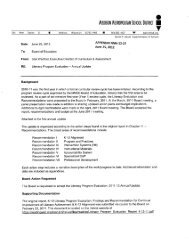
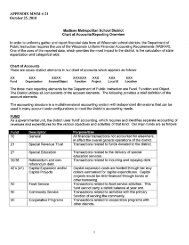
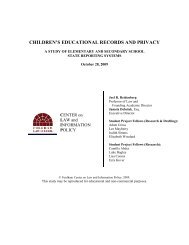

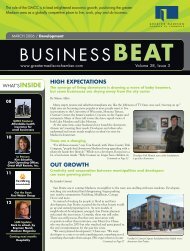
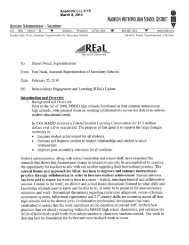

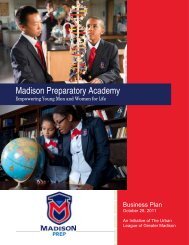
![by Shaina Wright [PDF] Ralph Waldo Emerson Prize 2006 - School ...](https://img.yumpu.com/26083584/1/174x260/by-shaina-wright-pdf-ralph-waldo-emerson-prize-2006-school-.jpg?quality=85)
